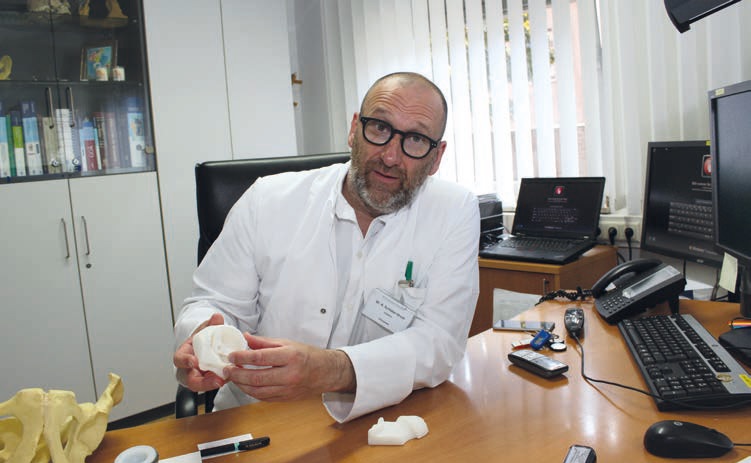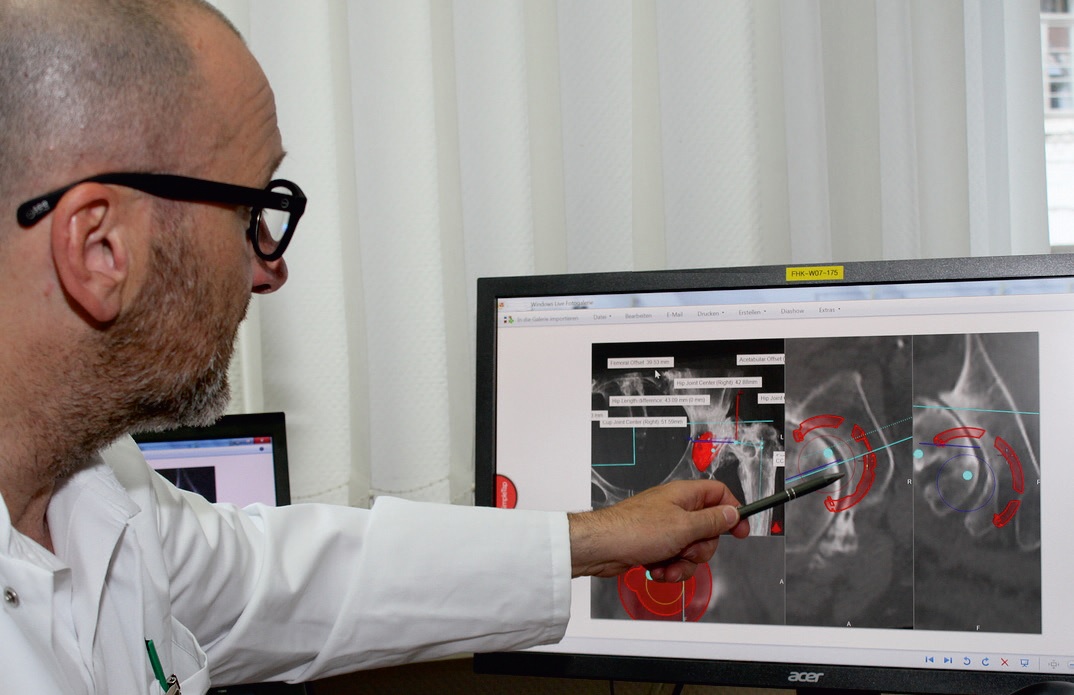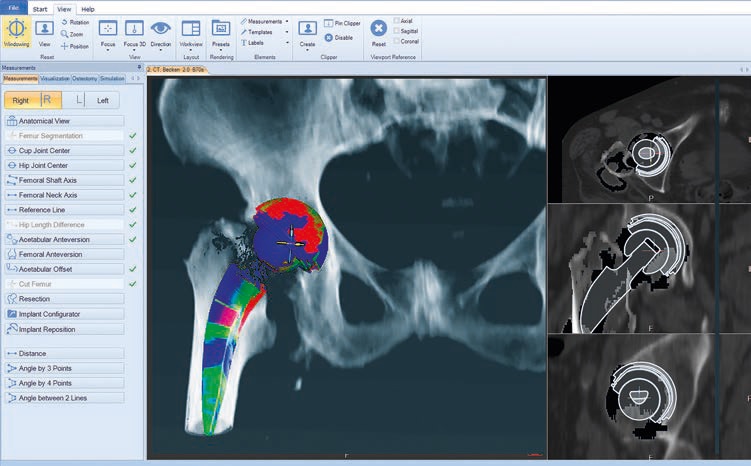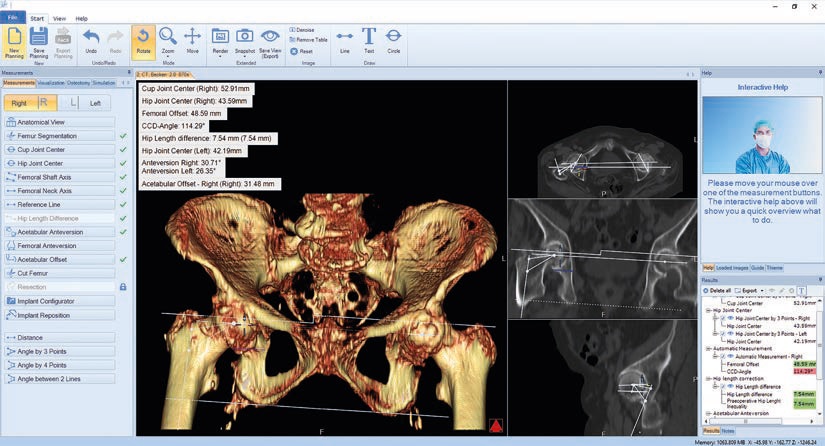



Published, 28.08.2022

St. Franziskus Hospital in Cologne-Ehrenfeld
Digital surgery planning is an integral part of orthopedics – if nothing else, simply because
of the associated automatic complete documentation. The quality and time savings are
also much higher than planning with films and templates. Nonetheless, not all digitally
planned surgeries lead to a satisfactory result for the patient or the surgeon. The new option
of planning on a computer screen instead of in only two dimensions as before promises
great benefits. Planning in 3D means all exact mechanical/geometric parameters can be
included. This enables tangible patient-specific prostheses.
Digital surgery planning in 3D
The Orthopedics I Clinic at the St. Franziskus Hospital in Cologne-
Ehrenfeld has been using digital planning for entire orthopedic
prostheses since 2006. The mediCAD® software from the mediCAD
Hectec company has proven itself as a two-dimensional
planning tool. The company has been working on the development
of the program continuously since 1994. More than 3000
clinics and orthopedics practices around the world use it. The digital
solution includes all planning methods, documents all processes
correctly and covers all orthopedics surgeries – from hips
to knees and spine, and feet and ankles. mediCAD® is certified
and approved worldwide as a medical product. The basis is an
implant database containing articles from more than 140 manufacturers.
In addition to implants, surgeons also find a comprehensive
range of osteosyntheses for planning in mediCAD®. In
addition to the traditional proven 2D solution, mediCAD Hectec
now also offers the corresponding 3D module components:
mediCAD Hip® 3D, mediCAD Knee® 3D and mediCAD Spine® 3D
are already on the market, and the planning software modules
for shoulders and feet, and a mediCAD® web-based solution will
follow in early 2018.
At a glance:
The St. Franziskus Hospital in Cologne has been relying on
three-dimensional planning for hip surgeries with mediCAD Hip®
3D for quite a while now and is already planning on using the all
new mediCAD Knee® 3D module.

For Chief Physician Dr. Klaus Schlüter-Brust, the increase in
precision, which results in higher safety, is the best feature. At
the same time, the software is so user-friendly and self-explanatory
that even new users can very quickly create good plans.
„After working together on three plans, an assistant physician
can work independently,“ says Schlüter-Brust. Since planning
takes less than five minutes, emergency surgeries can also be
planned as precisely and safely as elective surgeries. Volumetric
measurements, detection of abrasions and the preoperative
and postoperative comparisons have proven to be particularly
important and helpful functions. The measurement of the femoral
acetabular offset, the comparison of the healthy side to the
dysplastic side and the overall leg condition with knee surgeries
is just as important as, for example, planning of an osteotomy
of the knee and hip joints. As an endoprosthetics center that
provides maximum care, the Clinic must precisely document all
deviations from surgical plans. Using mediCAD Hip® 3D significantly
reduces these deviations and helps avoid intraoperative
complications. In the case of replacement of an endoprosthesis,
the measurement of the socket antetorsion and socket inclination
in the 3D space enables the detection of problems with the
previous prosthesis.
Patient-specific prosthetics
Since early 2017, the Clinic has been using the newly developed
version of mediCAD Hip® 3D, which allows three-dimensional
planning. After four months of using this new planning module,
Schlüter-Brust has a very positive overall impression. „Three-dimensional
planning allows for an unprecedented increase in
planning precision. It opens up the path to CT-based three-dimensional
navigation and the selection of patient-specific prostheses.“
The best possible prosthesis was able to be selected until now, but
a prosthesis that is an exact match can be created in the future.
Prosthesis manufacturers can produce a customized prosthesis
using the three-dimensional planning data. Together with patient-
specific cutting templates, this guarantees exact positioning of
the prosthesis at the planned optimal position.

An endoprosthetics center that provides maximum care
St. Franziskus Hospital is an academic teaching hospital with
around 300 beds and 800 employees. In one year, an average of
15,000 patients are hospitalized and 37,000 patients are treated
on an outpatient basis. The Orthopedics Clinic I, headed by Chief
Physician Dr. Klaus Schlüter-Brust, is certified as an „Endoprosthetics
center providing maximum care.“ Around 2100 patients in 42
beds are treated here annually. The digital planning software is
installed on eight PCs, which the five-person team uses to digitally
plan around 600 prosthesis surgeries per year, which are distributed
about equally between knee and hip surgeries.
Cost savings
mediCAD HIP® 3D also enables postoperative control and analysis
– an important step towards even greater safety for the patient.
Used preoperatively, 3D planning will open up the possibility
of dispensing with X-rays and CTs in favor of MRIs in the future.
Three-dimensional planning enables accurate preoperative measurement
of the patient‘s specific bone situation. This leads to
even more precise prosthesis planning and a reduction in filters
and instruments needed, resulting in considerable cost savings. Examples
of the higher planning accuracy include the exact detection
of tilt, torsion of the pelvis and the sacral slope. Schlüter-Brust is
convinced of one thing: „Even if three-dimensional planning takes
up to ten minutes instead of five minutes as before, the benefits for
the surgeon and the patient more than make up for that,“ he says.
This becomes even more clear in the case of complex operations,
such as inversion and dysplasia surgeries or Bechterew patients.
„Clinics that are now dealing with a choice of solutions for digital
surgical planning should make sure that three-dimensional
planning is included,“ says Schlüter-Brust. The mediCAD® product
range fulfills all requirements for modern surgical planning.

mediCAD Hip® 3D – the high performance tool for the hip surgeries of tomorrow
With the new 3D module mediCAD Hip® 3D software from the mediCAD Hectec company,
physicians will have completely new options for carrying out anatomical assessments,
planning and measurements of hips, enabling them to achieve optimal, revision-proof
surgery preparation.
The most important features of this new 3D module, which was developed in close collaboration
with hip surgery specialists, include:
